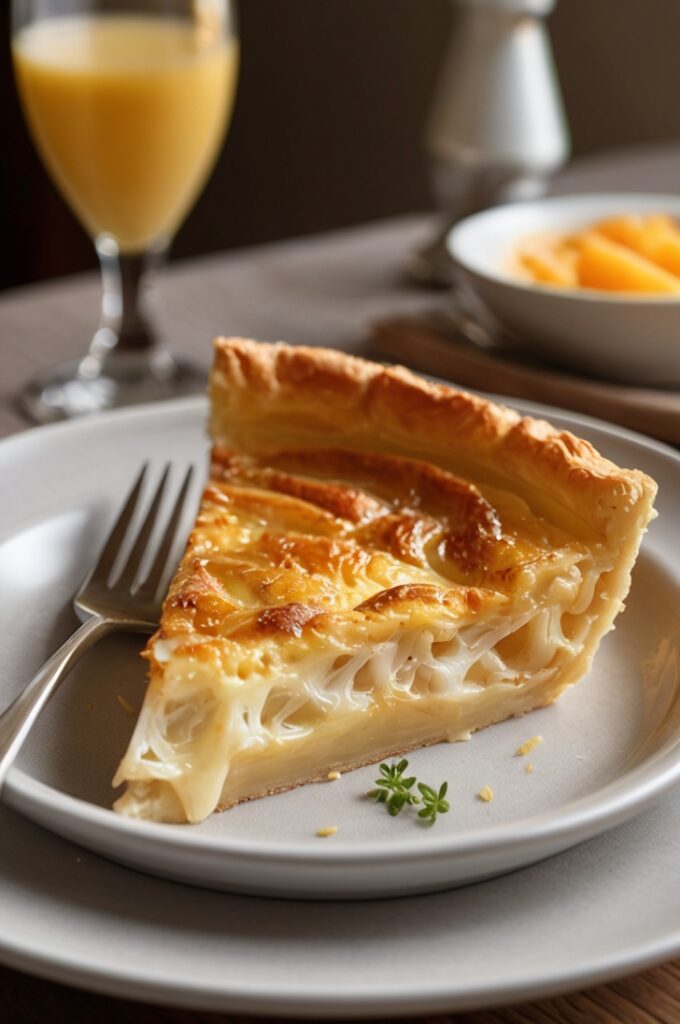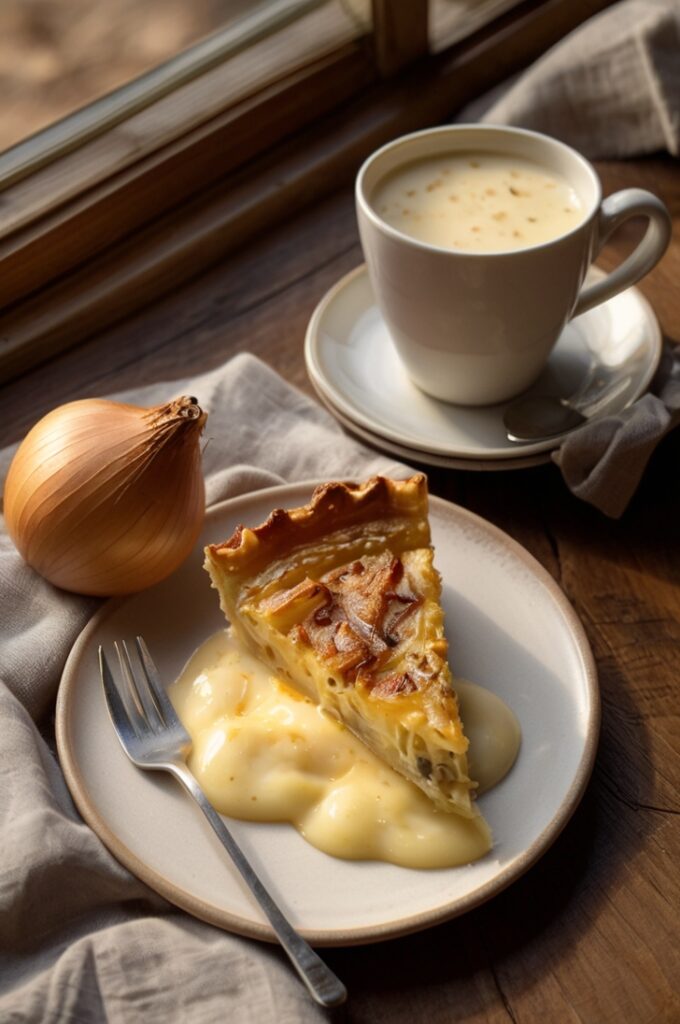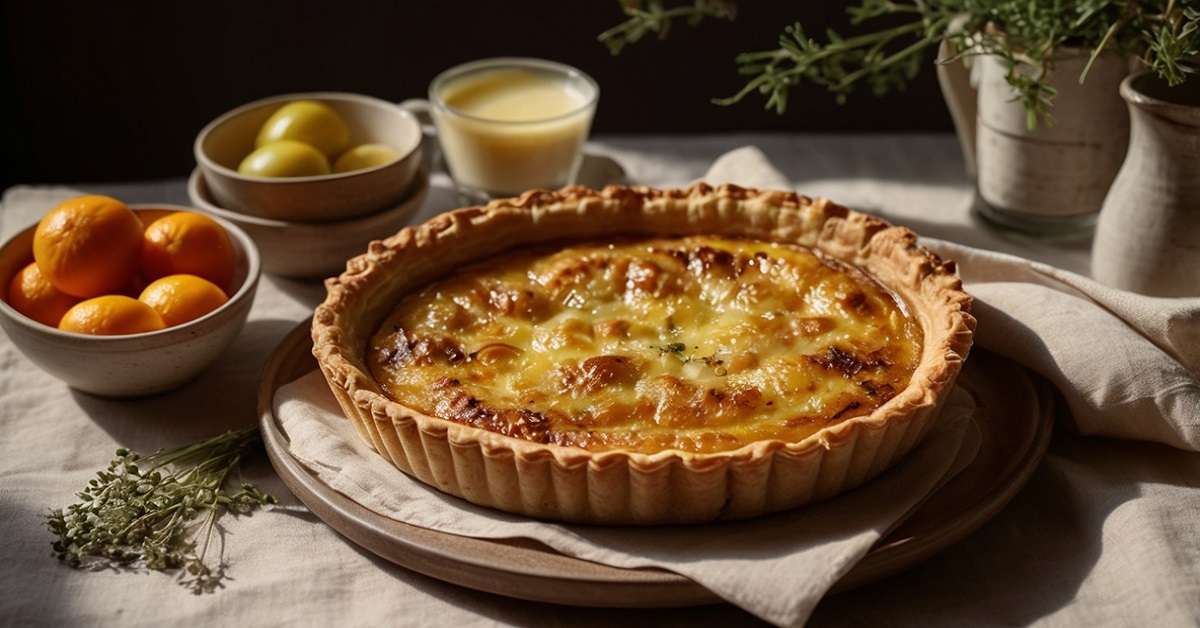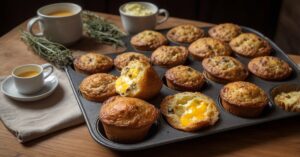Vidalia Onion Quiche for Easy Brunch Recipe you ever stand in your kitchen, bleary-eyed on a Sunday morning, trying to figure out what brunch should be? Not could be. Should be. Something that hits that soft middle between comfort and elegance.
That’s where this Vidalia onion quiche comes in like your favorite jazz tune, slow and smooth, no sharp edges. It’s the kind of dish that doesn’t shout, but hums. Warm. Buttery. And a little sweet, thanks to those Georgia-born Vidalias.
This isn’t your run-of-the-mill quiche, all rubbery eggs and watery spinach. No offense to spinach, bless it. But this one is built different. Built for flavor. For texture. For that moment at the table when forks pause and someone says, “Okay, who made this?”
Let’s dig into it like pros, yeah? Because the devil is always in the crust. And the angels? They’re hiding in the onions.
What Makes Vidalia Onion Quiche So Special?

First off, Vidalia onions aren’t just any sweet onion. Legally they’re protected by law they can only be grown in 20 counties in Georgia. They’re mild, almost delicate, with that juicy snap when raw and this caramel-like depth when cooked slow.
Put that flavor into a quiche? You get a custard that’s rich without being heavy. Silky. With a sweetness that balances the salt and fat like a tightrope walker on a breeze.
We’re talking flaky crust, melt-in-your-mouth onions, eggs that don’t curdle under pressure, and just the right amount of cheese to round it all out.
It’s brunch’s best-kept secret. And yeah, it’s easy enough to pull off on a lazy weekend.
But don’t confuse simple with boring. Simplicity done right? That’s magic.
Ingredients & Smart Substitutions
For the crust:
- 1 ¼ cups all-purpose flour (or sub with white spelt flour for nutty twist)
- ½ tsp kosher salt
- ½ cup (1 stick) unsalted butter, cold and cubed
- 3-4 tbsp ice water
For the filling:
- 2 large Vidalia onions, thinly sliced
- 2 tbsp unsalted butter
- 4 large eggs
- 1 ¼ cups half-and-half (or sub with whole milk + a splash of cream)
- 1 cup grated Gruyère (or aged cheddar, or even fontina if you’re feelin’ rich)
- ½ tsp salt
- ¼ tsp freshly ground black pepper
- Pinch of nutmeg (not optional, sorry)
- 1 tsp fresh thyme leaves (or ½ tsp dried, but fresh is so much better)
Ingredient Insights:
Flour: All-purpose is the default, but pastry flour gives you an even flakier crust if you can find it. Avoid bread flour it’s too protein-heavy and makes the crust tough.
Butter: It must be cold. Like out-the-fridge cold. You want those buttery bits to melt in the oven, not in your hands.
Onions: Don’t even try this with standard yellow onions. The Vidalia sweetness is key to balance the richness. If you can’t get them, go with Walla Walla or Maui as a backup, but it won’t be quite the same.
Cheese: Gruyère is classic it melts beautifully and adds just the right funk. But don’t let tradition box you in. Blue cheese? Not crazy. Smoked gouda? Go for it.
Step-by-Step Instructions (with Expert Tips)
1. Make the Crust
Dump the flour and salt into a bowl. Toss in the cubed butter. Use your fingers or a pastry cutter don’t go too hard till it looks like coarse sand with a few pea-sized bits. Those lil butter chunks? Gold.
Add ice water, 1 tbsp at a time, until the dough just holds when pressed. Don’t knead. You’re not makin’ bread. Wrap and chill for 30–60 mins. Cold dough = flakier crust. Every time.
2. Caramelize the Onions
Low heat. No shortcuts. Toss sliced Vidalias with butter in a wide pan. Let ’em melt down, stirring now and then, till golden and sweet. Could take 25–30 minutes. Don’t rush it. Rushing = bitterness.
3. Pre-Bake the Crust
Roll out the dough, slap it in a 9-inch tart pan (or pie dish), trim the edges. Dock it with a fork. Chill again, 15 minutes. Then bake at 375°F with pie weights or dried beans on parchment for 15 mins. Remove weights, bake 10 more.
Crust should look barely golden, not fully cooked. It’ll finish in the final bake.
4. Assemble the Filling
Whisk eggs, cream, salt, pepper, nutmeg. Stir in cheese and thyme. Fold in those dreamy onions.
Pour into the crust. Bake at 350°F for 30–40 mins. Should be puffed at the edges and just set in the middle. Jiggle it gently it should have a slight wobble. Like a good flan.
Let it cool a bit. Quiche needs a minute to gather itself before slicing.
Expert Mistakes to Dodge:
- Scrambling your custard: Pour warm onions into cold egg mix? Big nope. Let onions cool first.
- Over-baking: If you wait till the center is solid, it’s too late. Overbaked custard gets rubbery. Pull early.
- Under-seasoning: Cheese helps, but that filling needs salt and acid balance. Don’t be shy.
Cooking Techniques & a Bit of Science
Let’s get nerdy.
Why blind bake the crust?
Raw pastry + wet custard = soggy-bottom disaster. Blind baking sets the flour’s structure and gives the fat a head start to crisp things up. No more weepy slices.
What’s the deal with low-heat onions?
Caramelization happens around 320°F, but real onion flavor transformation starts way before that. You’re coaxing out natural sugars. High heat? That scorches. Slow cooking lets the Maillard reaction do its symphony thing.
Custard Ratio Matters
Classic French quiche runs around 1 egg per ½ cup dairy. Go lighter, it won’t set. Go heavier, it turns omelet-y. We’re keeping it classic here.
Tools that help (but aren’t required):
- A ceramic tart pan with removable bottom makes life easier.
- Offset spatula to help nudge slices out.
- A microplane for fresh nutmeg totally worth the tiny effort.
Serving & Pairing Suggestions

Serve warm or room temp. Never fridge-cold. That kills flavor, makes the fat waxy.
Serving Vibes:
- Top with fresh arugula tossed in lemon juice and olive oil. Adds that peppery snap.
- A tiny drizzle of hot honey or fig jam on the plate? Not traditional, but chefs kiss good.
- Sprinkle of flaky sea salt right before serving = sharp finish.
What to Serve With It?
- Drink: Crisp white wine like a Sauvignon Blanc or a lightly oaked Chardonnay.
- Side: Baby greens, roasted asparagus, or a frisée salad with Dijon vinaigrette.
- Brunch bonus: Crispy hash browns or even smoked salmon on the side if you wanna lean luxe.
FAQs About Vidalia Onion Quiche for Easy Brunch Recipe
1. Can I use a store-bought crust?
Absolutely. Just pick a good-quality all-butter version. Par-bake it like you would homemade.
2. What’s the best way to reheat quiche?
Low oven (around 300°F) for 10–15 mins. Cover loosely with foil so the crust doesn’t get too hard.
3. Can I freeze it?
Yep. Bake it, cool completely, then wrap tight and freeze. Reheat straight from frozen at 350°F for 20–25 mins.
4. Are Vidalia onions available year-round?
They’re seasonal (spring to late summer), but some stores stock them longer thanks to cold storage. Look for that “Vidalia” label.
5. How do I make it gluten-free?
Use a gluten-free pie crust recipe (with almond or rice flour). Rest the dough longer it’s more delicate.
And there you have it. A quiche that leans humble but delivers like a headliner. Next time you’re planning brunch or just need something that’ll hold in the fridge and still feel luxurious go with the Vidalia onion quiche.
It’s quiet genius. Just like the best dishes often are.
Final Thoughts from the Line
This isn’t just another egg dish. It’s layers of flavor tucked into a buttery crust. It’s old-school French technique with Southern soul. It’s the kinda thing you can make ahead and still wow folks.
Real talk? Quiche is forgiving. You can mess with fillings, cheeses, herbs. Just keep the ratios solid and respect the crust.
And don’t skimp on the onions. Never skimp the onions.




